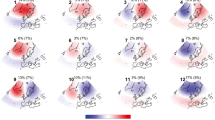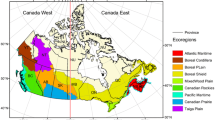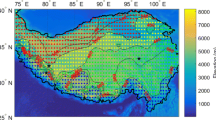Abstract
The Polar/Eurasia (POL) pattern was previously identified based on the empirical orthogonal function method and monthly mean data, in which the positive and negative phases are anti-symmetric in spatial distribution. This paper identifies the positive (POL+) and negative (POL−) phases of the POL pattern through applying a novel approach, i.e., self-organizing maps, to daily 500-hPa geopotential height fields in May over 1948–2017. The POL+, POL1−, and POL2− patterns defined by this method represent actual physical modes. The POL+ pattern features a wave train from the northeastern Atlantic/northern Europe via the subarctic regions of Eurasia to Lake Baikal. The POL1− pattern is characterized by a planetary-scale dipole pattern with a positive anomaly band over subarctic Eurasia and a negative anomaly band from central Asia to the Sea of Okhotsk. The anomaly centers of the POL2− pattern are basically anti-symmetrical to those of the POL+ pattern. The POL+ pattern increases the blocking frequency over the northeastern Atlantic/northern Europe and northeastern Asia, where high-frequency transient eddies are highly recurrent in the north. Accordingly, precipitation increases apparently in the subarctic Asian continent and western Siberia, and decreases around Europe and Lake Baikal. A mimic wave train is also observed in the surface air temperature anomaly field. During the POL1− period, the blocking frequency is abnormally high over Eurasia, whereas high-frequency transient eddies are apparently suppressed over northern Eurasia. Correspondingly, significant precipitation deficits are observed in northern Eurasia. The POL1− pattern also causes a remarkable temperature increase in the subarctic seas of Eurasia and a considerable temperature drop in the midlatitude Asian continent. As the POL2− pattern prevails, the blocking frequency decreases over the North Atlantic/Europe but strengthens over the Asian continent. The POL2− pattern also causes wavelike anomalies of precipitation and surface air temperature over northern Eurasia.
Similar content being viewed by others
References
Angell, J. K., 2006: Changes in the 300-mb north circumpolar vortex, 1963–2001. J. Climate, 19, 2984–2994, doi: https://doi.org/10.1175/JCLI3778.1.
Balling, R. C. Jr., and G. B. Goodrich, 2011: Interannual variations in the local spatial autocorrelation of tropospheric temperatures. Theor. Appl. Climatol., 103, 451–457, doi: https://doi.org/10.1007/s00704-010-0313-8.
Bao, M., and J. M. Wallace, 2015: Cluster analysis of Northern Hemisphere wintertime 500-hPa flow regimes during 1920–2014. J. Atmos. Sci., 72, 3597–3608, doi: https://doi.org/10.1175/JAS-D-15-0001.1.
Barnston, A. G., and R. E. Livezey, 1987: Classification, seasonality and persistence of low-frequency atmospheric circulation patterns. Mon. Wea. Rev., 115, 1083–1126, doi: https://doi.org/10.1175/1520-0493(1987)115<1083:CSAPOL>2.0.CO;2.
Bekryaev, R. V., I. V. Polyakov, and V. A. Alexeev, 2010: Role of polar amplification in long-term surface air temperature variations and modern Arctic warming. J. Climate, 23, 3888–3906, doi: https://doi.org/10.1175/2010JCLI3297.1.
Bengtsson, L., K. I. Hodges, and E. Roeckner, 2006: Storm tracks and climate change. J. Climate, 19, 3518–3543, doi: https://doi.org/10.1175/JCLI3815.1.
Bjerknes, J., 1969: Atmospheric teleconnections from the equatorial Pacific. Mon. Wea. Rev., 97, 163–172, doi: https://doi.org/10.1175/1520-0493(1969)097<0163:ATFTEP>2.3.CO;2.
Bueh, C., and Z. W. Xie, 2015: An objective technique for detecting large-scale tilted ridges and troughs and its application to an East Asian cold event. Mon. Wea. Rev., 143, 4765–4783, doi: https://doi.org/10.1175/MWR-D-14-00238.1.
Bueh, C., X. Y. Fu, and Z. W. Xie, 2011a: Large-scale circulation features typical of wintertime extensive and persistent low temperature events in China. Atmos. Ocean. Sci. Lett., 4, 235–241, doi: https://doi.org/10.1080/16742834.2011.11446935.
Bueh, C., N. Shi, and Z. W. Xie, 2011b: Large-scale circulation anomalies associated with persistent low temperature over Southern China in January 2008. Atmos. Sci. Lett., 12, 273–280, doi: https://doi.org/10.1002/asl.333.
Bueh, C., Y. Li, D. W. Lin, et al., 2016: Interannual variability of summer rainfall over the northern part of China and the related circulation features. J. Meteor. Res., 30, 615–630, doi: https://doi.org/10.1007/s13351-016-5111-5.
Cai, M., and M. Mak, 1990: Symbiotic relation between planetary and synoptic-scale waves. J. Atmos. Sci., 47, 2953–2968, doi: https://doi.org/10.1175/1520-0469(1990)047<2953:SRBPAS>2.0.CO;2.
Cavazos, T., 1999: Large-scale circulation anomalies conducive to extreme precipitation events and derivation of daily rainfall in Northeastern Mexico and Southeastern Texas. J. Climate, 12, 1506–1523, doi: https://doi.org/10.1175/1520-0442(1999)012<1506:LSCACT>2.0.CO;2.
Chen, D., C. Bueh, and K. Y. Zhu, 2013: Interannual and interdecadal variabilities of circulation over Lake Baikal region in late spring and their association with temperature and precipitation over China. Chinese J. Atmos. Sci., 37, 1199–1209, doi: https://doi.org/10.3878/j.issn.1006-9895.2012.12155. (in Chinese)
Dai, P. X., and B. K. Tan, 2017: The nature of the Arctic Oscillation and diversity of the extreme surface weather anomalies it generates. J. Climate, 30, 5563–5584, doi: https://doi.org/10.1175/JCLI-D-16-0467.1.
Esbensen, S. K., 1984: A comparison of intermonthly and interannual teleconnections in the 700 mb geopotential height field during the Northern Hemisphere winter. Mon. Wea. Rev., 112, 2016–2032, doi: https://doi.org/10.1175/1520-0493(1984)112<2016:ACOIAI>2.0.CO;2.
Feldstein, S. B., and S. Lee, 2014: Intraseasonal and interdecadal jet shifts in the Northern Hemisphere: The role of warm pool tropical convection and sea ice. J. Climate, 27, 6497–6518, doi: https://doi.org/10.1175/JCLI-D-14-00057.1.
Franzke, C., and S. B. Feldstein, 2005: The continuum and dynamics of Northern Hemisphere teleconnection patterns. J. Atmos. Sci., 62, 3250–3267, doi: https://doi.org/10.1175/JAS3536.1.
Frauenfeld, O. W., and R. E. Davis, 2003: Northern Hemisphere circumpolar vortex trends and climate change implications. J. Geophys. Res. Atmos., 108, 4423, doi: https://doi.org/10.1029/2002JD002958.
Gong, D. Y., and C. H. Ho, 2003: Arctic oscillation signals in the East Asian summer monsoon. J. Geophys. Res. Atmos., 108, 4066, doi: https://doi.org/10.1029/2002JD002193.
Goss, M., S. B. Feldstein, and S. Lee, 2016: Stationary wave interference and its relation to tropical convection and Arctic warming. J. Climate, 29, 1369–1389, doi: https://doi.org/10.1175/JCLI-D-15-0267.1.
He, J., and R. X. Black, 2016: Heat budget analysis of Northern Hemisphere high-latitude spring onset events. J. Geophys. Res. Atmos., 121, 10113–10137, doi: https://doi.org/10.1002/2015JD024681.
Horel, J. D., 1981: A rotated principal component analysis of the interannual variability of the Northern Hemisphere 500 mb height field. Mon. Wea. Rev., 109, 2080–2092, doi: https://doi.org/10.1175/1520-0493(1981)109<2080:ARPCAO>2.0.CO;2.
Hoskins, B. J., and K. I. Hodges, 2002: New perspectives on the Northern Hemisphere winter storm tracks. J. Atmos. Sci., 59, 1041–1061, doi: https://doi.org/10.1175/1520-0469(2002)059<1041:NPOTNH>2.0.CO;2.
Hoskins, B. J., M. E. McIntyre, and A. W. Robertson, 1985: On the use and significance of isentropic potential vorticity maps. Quart. J. Roy. Meteor. Soc., 111, 877–946, doi: https://doi.org/10.1256/smsqj.47001.
Hsu, H. H., and J. M. Wallace, 1985: Vertical structure of wintertime teleconnection patterns. J. Atmos. Sci., 42, 1693–1710, doi: https://doi.org/10.1175/552-0469(1998)042<1693:VSOWTP>2.0.CO;2.
Hurrell, J. W., 1996: Influence of variations in extratropical wintertime teleconnections on Northern Hemisphere temperature. Geophys. Res. Lett, 23, 665–668, doi: https://doi.org/10.1029/96GL00459.
Johnson, N. C., 2013: How many ENSO flavors can we distinguish? J. Climate, 26, 4816–4827, doi: https://doi.org/10.1175/JCLI-D-12-00649.1.
Johnson, N. C., and S. B. Feldstein, 2010: The continuum of North Pacific sea level pressure patterns: Intraseasonal, interannual, and interdecadal variability. J. Climate, 23, 851–867, doi: https://doi.org/10.1175/2009JCLI3099.1.
Johnson, N. C., S. B. Feldstein, and B. Tremblay, 2008: The continuum of Northern Hemisphere teleconnection patterns and a description of the NAO shift with the use of self-organizing maps. J. Climate, 21, 6354–6371, doi: https://doi.org/10.1175/2008JCLI2380.1.
Kalnay, E., M. Kanamitsu, R. Kistler, et al., 1996: The NCEP/NCAR 40-year reanalysis project. Bull. Amer. Meteor. Soc., 77, 437–472, doi: https://doi.org/10.1175/1520-0477(1996)077<0437:TNYRP>2.0.CO;2.
Kohonen, T., 1990: The self-organizing map. Proc. IEEE, 78, 1464–1480, doi: https://doi.org/10.1109/5.58325.
Kohonen, T., 1997: Self-Organizing Maps. Springer-Verlag, Berlin, Heidelberg, 426 pp.
Kushnir, Y., and J. M. Wallace, 1989: Low-frequency variability in the Northern Hemisphere winter: Geographical distribution, structure and time-scale dependence. J. Atmos. Sci., 46, 3122–3143, doi: https://doi.org/10.1175/1520-0469(1989)046<3122:LFVTTN>2.0.CO;2.
Lee, M. H., S. Lee, H. J. Song, et al., 2017: The recent increase in the occurrence of a boreal summer teleconnection and its relationship with temperature extremes. J. Climate, 30, 7493–7504, doi: https://doi.org/10.1175/JCLI-D-16-0094.1.
Lee, S., and S. B. Feldstein, 2013: Detecting ozone- and greenhouse gas-driven wind trends with observational data. Science, 339, 563–567, doi: https://doi.org/10.1126/science.1225154.
Lehmann, J., D. Coumou, K. Frieler, et al., 2014: Future changes in extratropical storm tracks and baroclinicity under climate change. Environ. Res. Lett., 9, 084002, doi: https://doi.org/10.1088/1748-9326/9/8/084002.
L’Heureux, M. L., D. C. Collins, and Z. Z. Hu, 2013: Linear trends in sea surface temperature of the tropical Pacific Ocean and implications for the El Niño-Southern Oscillation. Climate Dyn., 40, 1223–1236, doi: https://doi.org/10.1007/s00382-012-1331-2.
Lin, Z. D., 2014: Intercomparison of the impacts of four summer teleconnections over Eurasia on East Asian rainfall. Adv. Atmos. Sci., 31, 1366–1376, doi: https://doi.org/10.1007/s00376-014-3171-y.
Lin, Z. D., and B. Wang, 2016: Northern East Asian low and its impact on the interannual variation of East Asian summer rainfall. Climate Dyn., 46, 83–97, doi: https://doi.org/10.1007/s00382-015-2570-9.
Liu, Y. G., R. H. Weisberg, and C. N. K. Mooers, 2006: Performance evaluation of the self-organizing map for feature extraction. J. Geophys. Res. Oceans, 111, C05018, doi: https://doi.org/10.1029/2005JC003117.
Nakamura, H., M. Nakamura, and J. L. Anderson, 1997: The role of high- and low-frequency dynamics in blocking formation. Mon. Wea. Rev., 125, 2074–2093, doi: https://doi.org/10.1175/1520-0493(1997)125<2074:TROHAL>2.0.CO;2.
Pelly, J. L., and B. J. Hoskins, 2003: A new perspective on blocking. J. Atmos. Sci., 60, 743–755, doi: https://doi.org/10.1175/1520-0469(2003)060<0743:ANPOB>2.0.CO;2.
Piao, J. L., W. Chen, S. F. Chen, et al., 2018: Intensified impact of North Atlantic Oscillation in May on subsequent July Asian inland plateau precipitation since the late 1970s. Int. J. Climatol., 38, 2605–2612, doi: https://doi.org/10.1002/joc.5332.
Reusch, D. B., R. B. Alley, and B. C. Hewitson, 2007: North Atlantic climate variability from a self-organizing map perspective. J. Geophys. Res. Atmos., 112, D02104, doi: https://doi.org/10.1029/2006JD007460.
Rousi, E., C. Anagnostopoulou, K. Tolika, et al., 2015: Representing teleconnection patterns over Europe: A comparison of SOM and PCA methods. Atmos. Res., 152, 123–137, doi: https://doi.org/10.1016/j.atmosres.2013.11.010.
Sheridan, S. C., and C. C. Lee, 2011: The self-organizing map in synoptic climatological research. Prog. Phys. Geogr., 35, 109–119, doi: https://doi.org/10.1177/0309133310397582.
Tan, B. K., and W. Chen, 2014: Progress in the study of the dynamics of extratropical atmospheric teleconnection patterns and their impacts on East Asian climate. J. Meteor. Res., 28, 780–802, doi: https://doi.org/10.1007/s13351-014-4041-3.
Wallace, J. M., and D. S. Gutzler, 1981: Teleconnections in the geopotential height field during the Northern Hemisphere winter. Mon. Wea. Rev., 109, 784–812, doi: https://doi.org/10.1175/1520-0493(1981)109<0784:TITGHF>2.0.CO;2.
Ward, J. H. Jr., 1963: Hierarchical grouping to optimize an objective function. J. Am. Stat. Assoc., 58, 236–244, doi: https://doi.org/10.2307/2282967.
Xie, Z., R. X. Black, and Y. Deng, 2017: Daily-scale planetary wave patterns and the modulation of cold season weather in the northern extratropics. J. Geophys. Res. Atmos., 122, 8383–8398, doi: https://doi.org/10.1002/2017JD026768.
Xie, Z. W., and C. Bueh, 2017a: Cold vortex events over Northeast China associated with the Yakutsk-Okhotsk blocking. Int. J. Climatol., 37, 381–398, doi: https://doi.org/10.1002/joc.4711.
Xie, Z. W., and C. Bueh, 2017b: Blocking features for two types of cold events in East Asia. J. Meteor. Res., 31, 309–320, doi: https://doi.org/10.1007/s13351-017-6076-8.
Xu, G. D., Y. Zong, and Z. L. Yang, 2013: Applied Data Mining. CRC Press, Inc., Boca Raton, FL, USA, 284 pp.
Yatagai, A., K. Kamiguchi, O. Arakawa, et al., 2012: APHRODITE: Constructing a long-term daily gridded precipitation dataset for Asia based on a dense network of rain gauges. Bull. Amer. Meteor. Soc., 93, 1401–1415, doi: https://doi.org/10.1175/BAMS-D-11-00122.1.
Ye, H. C., E. J. Fetzer, A. Behrangi, et al., 2016: Increasing daily precipitation intensity associated with warmer air temperatures over northern Eurasia. J. Climate, 29, 623–636, doi: https://doi.org/10.1175/JCLI-D-14-00771.1.
Yeh, T. C., S. Y. Dao, and M. T. Li, 1958: The abrupt change of circulation over Northern Hemisphere during June and October. Acta Meteor. Sinica, 29, 249–263. (in Chinese)
Yuan, J. C., B. K. Tan, S. B. Feldstein, et al., 2015: Wintertime North Pacific teleconnection patterns: Seasonal and interannual variability. J. Climate, 28, 8247–8263, doi: https://doi.org/10.1175/JCLI-D-14-00749.1.
Acknowledgments
We thank the writers of NCARG Command Language (UCAR/NCAR/CISL/TDD 2017), which was used to plot the figures in this paper.
Author information
Authors and Affiliations
Corresponding author
Additional information
Supported by the National Science and Technology Support Program of China (2015BAC03B03) and National Natural Science Foundation of China (41630424, 41875078, and 41861144014).
Rights and permissions
About this article
Cite this article
Gao, N., Bueh, C., Xie, Z. et al. A Novel Identification of the Polar/Eurasia Pattern and Its Weather Impact in May. J Meteorol Res 33, 810–825 (2019). https://doi.org/10.1007/s13351-019-9023-z
Received:
Accepted:
Published:
Issue Date:
DOI: https://doi.org/10.1007/s13351-019-9023-z




